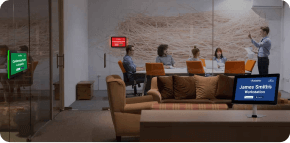Blog

Hybrid Workplace Management Software Purchase Guide in 2024
An efficient and effective work setup has always been crucial to the changing modern workplaces. When it comes to recent years, there is no doubt that companies are here seeking comprehensive solutions that can aid their everyday operations.
In this article, we’ll examine how integrated hybrid workplace management software (IWMS) may transform your workplace and support your success in today’s mobile workforce.
Understanding Integrated Workplace Management Software
Integrated workplace management software is an advanced software solution for organization and office aid.
Some of its known uses highlight organizing and managing facilities, real estate portfolios, and related assets in the most integrated way. In other words, the software functions through a centralized system, allowing the management to handle and delegate tasks efficiently.
Here are some key functionalities that IWMS offers:
1. Managing Facilities
Incorporating IWMS in one’s workplace will allow them to handle their facilities uniformly and centrally.
For example, schedules and task delegation are essential in taking work orders. The software supports automated scheduling and a work tracker, ensuring progress. That way, management can reduce downtime and operational disruptions.
2. Real Estate Management
Real estate management is another significant use of IWMS. This software supports accurate tracking of lease terms and compliance requirements, facilitating more efficient negotiations and better leasing agreements.
It helps companies save administrative overhead by keeping ahead of lease renewals and managing their properties more effectively.
Financial management and reporting tools capabilities that offer insights into potential investments and cost reductions are also included with IWMS.
3. Space Planning and Optimization
Planning and maximizing space usage are critical tasks for IWMS. This software tracks occupancy trends, giving management valuable insights into how office space is being used.
These insights are key for adjusting the office layout, guaranteeing that space is used efficiently and meets the company’s goals.
For example, if a particular meeting room is consistently underused, IWMS can flag this, allowing management to repurpose the space for other functions like creating a quiet zone or collaborative area.
4. Asset Management
This integrated workplace management software is also reliable in managing one’s assets. In the office, the utilization of physical assets is also crucial. A company must ensure its employees properly utilize its furniture, equipment, and other physical resources.
For example, an advertising company with its photoshoot equipment should have a systematic allocation—record who booked and utilized these equipment and track how they used them.
That way, these resources are thoroughly accounted for and utilized. Also, the management can maintain it for the long run.
5. Request for Service
The software solution can also be a communication platform. It can serve as an outlet for employees to send their service requests to the management efficiently.
For example, suppose there is a maintenance issue for their equipment; instead of requesting it verbally, they can now issue it through the IWMS platform.
Another thing is that room bookings are also possible through it. They can inform the management to reserve a particular room for them to accommodate. In all aspects, IWMS aims to enhance the communication and responsiveness of everyone involved.
6. Compliance Monitoring
The IWMS is also commendable for monitoring and ensuring that facilities, real estate, or other resources follow the standards and safety regulations.
It is one way for the organization to comply and avoid penalties. In addition, it is the best way to ensure a safe and sound work environment.
7. Access to Analytics
This software solution gathers data that will help in the long run. Most of the time, the software generates insights and analytics according to that information.
For instance, optimizing space allocation starts with analyzing the data from past space utilization. That also goes through the other features, whereas the data-driven will help the management decide and address different work operations.
These are some of the standard functionalities that highlight integrated workplace management software.
5 Benefits of Integrated Workplace Management Software
Let’s analyze the key benefits of IWMS implementation for your company.
- Operational efficiency: As the software streamlines facility management, it also reduces manual efforts. It only means an organization can have an automated procedure for handling facilities. In other aspects, it also lessens errors like the ones that used to occur with manual management.
- Optimizing space utilization: In addition to facilities and real estate, the software provides excellent support for optimizing space utilization. It collects data on space occupancy and usage patterns and formulates its insight here. The organization can use this information for reflection and future improvements, strengthening efficient workspace usage.
- Improved asset management: Incorporating IWMS in one’s workplace also means having a reliable tracker for physical resources. Handling assets is essential as these are the organization’s long-term investment. Hence, with better management, these assets can have better maintenance and a longer lifecycle. It also lessens downtime while continuously improving reliability.
- Cost-effective solution: The data insights will help the organization enhance its resource allocation and planning. From handling assets to real estate management, they will have a guide on how to utilize them. Their sound decision on their work operations will save them from extra costs.
- Comprehensive reporting: Software tools like IWMS guarantee a return after its usage. In other words, it can generate comprehensive reports for aspects like facility and asset management. The analysis will help the organization oversee its work environment. It is another outlet for them to strengthen productivity and see the further improvement they may need.
Getting Started with Integrated Workplace Management Software
Getting started with IWMS involves carefully evaluating your organization’s needs and choosing the right solution to address inefficiencies, such as space usage and maintenance concerns.
Here’s a step-by-step guide:
Evaluate Your Organization’s Needs
Incorporating the workplace with an IWMS solution is a shift to the existing system, especially if the office runs traditionally. It is vital to understand deeply whether the organization or office needs it.
Another consideration is comprehending the organization’s real estate, facilities, and asset management requirements. Review all the pain points and see how the software can help.
Choose the Right IWMS Solution
Every IWMS features different advantages; thus, as mentioned earlier, pinpointing the reason for getting it is essential. Choose the right IWMS platform that aligns with the organization’s goals and needs.
Scalability, user-friendliness, and integration capabilities are critical factors to consider when selecting software products.
Budget allocation is also a vital factor before purchasing a product. So, research the one that suits your budget while maintaining your objectives and requirements.
Data Integration and Migration
Once the organization has chosen and installed the IWMS, this part comes next. Migrating and integrating existing data into the software application allows the management to continue what they already have.
Transfer the relevant data to the IWMS platform to better view the organization’s workspace. And for that, choosing the one with smooth integration can make it possible.
Employee Training
This system shift will need time and effort for everyone to adapt to it. Therefore, team member training is a must. The organization must let employees understand how the software works and why they need it.
Provide enough time for them to adjust and master this IWMS application. Some employees may find it complex, so ensure that everyone is on the same track. Maximizing the benefits begins when everyone uses it.
Optimize Space Utilization
Once everyone is already using it, it is time to use it for better space allocation. Make the most of the IWMS solution by starting with efficient space planning.
Organizations and offices that use a hybrid work schedule setting can use workplace management software to delegate desks and rooms for remote workers whenever they are on site.
The software app can also help with better office layouts. Take the data-driven and its analytics, then decide how to improve the work environment.
Streamline Facilities Maintenance
Use the IWMS to improve everyday operations and automate maintenance workflow. Instead of delivering workloads manually, use the platform to delegate the tasks.
Monitor work orders efficiently as the application has a real-time dashboard showing progress. Manage service requests by directly receiving them through the platform. All of this can reduce downtime while increasing productivity.
Improve Lease Management
Use the software application for advanced and effective lease administration. Tracking lease terms, renewals, and compliance is commendable, as everything is automated.
This means that once the client has a concern, management can immediately address it. Thus, the software aids in negotiating favorable lease agreements and managing costs.
Use the Software Analytics
Advanced integrated workplace management software comes with an analytics feature. You can take advantage of this feature as it will help the organization in everyday work and the long run. The data-driven insights speak about how the office functions.
Use the information in formulating decisions. That will help management grow and prosper, not just in everyday life but also in the future.
Regularly Update and Optimize
As the software brings promising benefits to the office, keeping it up to date and optimizing it is also vital. Use it with the utmost capabilities by being informed of the updates and enhancements.
Also, remember to review it regularly. See and ensure that the software continues to support the organization’s needs. That way, it ensures that the organization utilizes it with great returns.
Seek User’s Feedback
From time to time, management must also encourage their users to give direct feedback on the software app. This will help them collectively see satisfaction and concerns.
Management can also make adjustments and address those matters to support one another’s productivity. Besides, the organization gets IWMS for better work operations.
Choosing the Right Hybrid Work Software
When selecting the best IMWS, focus on essential factors like data collection, flexibility, and integration with existing tools.
- Data collection and reporting: Choose software that offers real-time data insights on space usage, employee attendance, and workplace analytics. This allows data-driven decisions for resource allocation and space management.
- Support for hybrid work models: Ensure the software accommodates both remote and in-office work, allowing for easy scheduling and work arrangements that suit your hybrid workforce.
- Integration with existing tools: Syncing up with Google Workspace and Microsoft Teams helps maintain a smooth workflow, where teamwork flows freely and easily.
How DeskFlex Can Power Your Hybrid Work Model
DeskFlex is the perfect solution for making your digital workplace run smoothly, especially if your team is navigating a hybrid or flexible work environment. Let’s break down how DeskFlex can help:
- Simple desk booking: DeskFlex makes it easy for employees to reserve a desk or workstation when they need it. No more scrambling to find a spot in the office. Employees can check availability and book a desk ahead of time, making sure they have a place to work when they come in.
- Room and resource scheduling: Need a meeting room or special equipment? DeskFlex has you covered. It lets employees book conference rooms or other office resources just as easily as desks. This keeps everything organized and prevents double booking or fighting over spaces.
- Hybrid work management: For businesses juggling both in-office and remote work, DeskFlex makes managing it all a breeze. It helps you balance office attendance, track who’s coming in, and even manage hot-desking policies. You’ll know exactly how your office space is being used and can adjust it based on real-time data.
- Visitor management: Control who can come in and out of your workplace and determine valid visitors, such as delivery people, renters, customers, and job applicants.
Ready to see how DeskFlex can support hybrid work? Book a live demo today!
FAQs About Hybrid Workplace Management Software
What is Integrated Workplace Management Software (IWMS)?
IWMS is a centralized platform that helps businesses manage assets, real estate, and office spaces efficiently. It is used for facilities management, space optimization, real estate tracking, and supporting hybrid work environments.
How can IWMS improve productivity for hybrid employees?
IWMS provides tools for space planning, asset management, and real-time data analytics, helping hybrid teams schedule resources, collaborate better, and optimize the use of office spaces, resulting in higher employee productivity.
How does hybrid workplace management software promote work-life balance?
Hybrid workplace management software enables flexible scheduling, allowing remote and in-office employees to better balance their personal and professional lives.
Can hybrid workplace management software integrate remote and in-office employees in a single platform?
Yes, hybrid workplace management software allows remote and in-office employees to collaborate on a single platform. This integration supports hybrid work environments by offering features like desk booking, meeting room scheduling, and real-time communication tools, ensuring all employees stay connected regardless of their location.
What role does hybrid workplace management software play in optimizing office space for a hybrid work environment?
Hybrid workplace management software uses real-time data to track space usage, allowing companies to optimize office layouts and allocate resources effectively. For hybrid working environments, this means better management of desk assignments, meeting rooms, and shared spaces, ensuring that in-office employees and remote employees have access to the resources they need when they need them.









